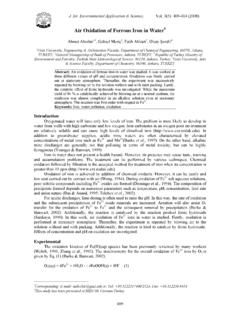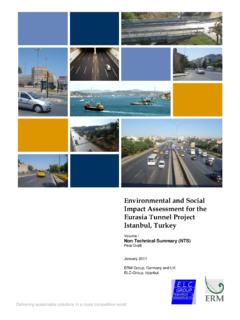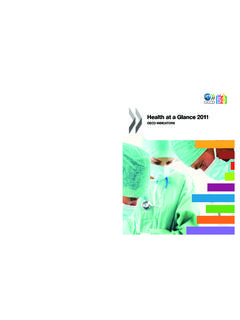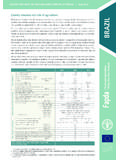Transcription of 85 WHO Regional Publications, European Series, No. 85
1 WHO Regional Publications, European series , No. 8585 Monitoring ambient air qualityfor health impact assessmentWHO Library Cataloguing in publication DataMonitoring ambient air quality for health impact assessment(WHO Regional publications. European series ; No. 85) pollution prevention and control monitoring methods assessment pollutants adverse control exposure 92 890 1351 6(NLM Classification: WA 754) ISSN 0378-2255 Text editing: David BreuerMonitoring ambientair quality for health impact assessmentWHO Regional Publications, European series , No. 85 World health OrganizationRegional Office for EuropeCopenhagenISBN 92 890 1351 6 ISSN 0378-2255 The Regional Office for Europe of the World health Organization wel-comes requests for permission to reproduce or translate its Publications, in part or in full.
2 Applications and enquiries should be addressed to thePublications unit, WHO Regional Office for Europe, Scherfigsvej 8,DK-2100 Copenhagen , Denmark, which will be glad to provide thelatest information on any changes made to the text, plans for new edi-tions, and reprints and translations already available. World health Organization 1999 Publications of the World health Organization enjoy copyright protec-tion in accordance with the provisions of Protocol 2 of the UniversalCopyright Convention. All rights designations employed and the presentation of the material inthis publication do not imply the expression of any opinion whatsoeveron the part of the Secretariat of the World health Organization con-cerning the legal status of any country, territory, city or area or of its au-thorities, or concerning the delimitation of its frontiers or names of countries or areas used in this publication are those thatobtained at the time the original language edition of the book was mention of specific companies or of certain manufacturers products does not imply that they are endorsed or recommended by theWorld health Organization in preference to others of a similar naturethat are not mentioned.
3 Errors and omissions excepted, the names ofproprietary products are distinguished by initial capital views expressed in this publication are those of the author anddo not necessarily represent the decisions or the stated policy of theWorld health ..ixForeword ..xiExecutive summary .. xiii1. Introduction ..1 Objectives and scope ..2 Structure of the publication ..3 Previous related activities of WHO ..4 References ..62. Information on air quality required for health impact assessment ..9 Otto H nninen, Alexander Economopoulos & Hal k zkaynakIntroduction ..9 Air quality and health impact assessment ..10 Relationship between information on air quality and exposure16 Relevance of exposure to health effects ..23 Air quality and sources: from assessment to management.
4 28 References ..353. Design, operation and quality assurance and control in a monitoring system ..37 Jon Bower & Hans-Guido M ckeThe role of monitoring ..37 Objectives of monitoring and quality assurance and control ..38 Role and functions of quality assurance and quality control ..41 Network design ..43 Instrumental issues ..52 System review ..55 System operation: automatic networks ..55 System operation: sampler networks ..59 Data management ..62 Turning data into information ..64 References ..674. Strategies for monitoring selected pollutants ..71 Carbon monoxide ..72P ivi Aarnio, Tarja Koskentalo & Kari H mekoskiOzone ..78 Ruth Baumann & J rgen SchneiderSulfur dioxide ..84 Bohumil Kotlik & Jon BowerNitrogen dioxide ..91 Jon BowerParticulate matter (PM10and ).
5 99 Michal KrzyzanowskiBenzene .. 107 Anne LindskogPolycyclic aromatic hydrocarbons .. 112 Eva Brorstr m-Lund nLead .. 118 Bohumil KotlikAtmospheric cadmium .. 123 Laszlo Boz 5. Reporting and assessment .. 127 Dietrich Schwela & Michal KrzyzanowskiReporting .. 127 Assessment .. 128 Formats for presenting information .. 129 Storing data .. 135 References .. 1356. Conclusions and recommendations .. 137 Annex 1. Major European activities related to air quality assessment .. 139 Annex Overview of the updated WHO air quality guidelines for Europe .. 139 Rolaf van Leeuwen & Michal KrzyzanowskiAnnex European Union framework directive and daughter directives .. 145 Frank de LeeuwAnnex 2. General methods for emission inventories .. 149 Alexander EconomopoulosAnnex 3.
6 Air quality modelling .. 155 Annex Dispersion models .. 155 Jaakko KukkonenAnnex Receptor modelling .. 160 Juhani RuuskanenAnnex Statistical models of air quality .. 165 John StedmanAnnex 4. Personal exposure models .. 171 Hal k zkaynakAnnex 5. WHO requirements for air quality indicators .. 181 ContributorsEditorial groupJon BowerOtto H nninenBohumil KotlikHans-Guido M ckeHal k zkaynakStanislaw Tarkowski (Chairperson)Michal Krzyzanowski (Scientific Secretary)Members of the working group (P = preparatory group, WG = working group)Ruth Baumann, Federal Environment Agency, Vienna, Austria (WG)Jon Bower, AEA Technology, Culham, United Kingdom (WG)Laszlo Boz , Institute for Atmospheric Physics, Budapest, Hungary (WG)Sergei S. Chicherin, Federal Service of Russia for Hydrometeorologyand Monitoring Environment, St.
7 Petersburg, Russian Federation (WG)Alexander Economopoulos, Technical University of Crete, Chania,Greece (WG)Paul Filliger, Swiss Agency for the Environment, Forests and Landscape, Berne, Switzerland (WG)Cagatay G ler, Hacettepe University, Ankara, Turkey (WG)Kari H mekoski, Helsinki Metropolitan Area Council, Helsinki, Finland (WG)Otto H nninen, KTL Environmental health , Kuopio, Finland (P, WG)Bohumil Kotlik, National Institute for Public health , Prague, Czech Republic (P, WG)Steinar Larssen, Norwegian Institute for Air Research (NILU), Kjeller, Norway (WG)Frank de Leeuw, National Institute of Public health and the Environment, Bilthoven, the Netherlands (Pa)Anne Lindskog, Swedish Environmental Research Institute (IVL),Gothenburg, Sweden (WG)ixHans-Guido M cke, Institute for Water, Soil and Air Hygiene, Berlin, Germany (Pb, WG)Hal k zkaynak, Harvard School of Public health , Boston, Massachusetts, USA (WG)Juhani Ruuskanen, University of Kuopio, Kuopio, Finland (WG)Romualdas Sabaliauskas, Ministry of health , Vilnius, Lithuania (WG)Jaroslav Santroch, Czech Hydrometeorological Institute, Prague,Czech Republic (WG)Dietrich Schwela, World health Organization, Geneva, Switzerland (P)Katarina Slotova, Specialized State Institute of Public health , Bansk Bystrica, Slovakia (WG)John Stedman, AEA Technology, Culham, United Kingdom (WGb)Stanislaw Tarkowski, Nofer Institute of Occupational Medicine, Lodz,Poland (WGa)William E.
8 Wilson, US Environmental Protection Agency, Research Triangle Park, North Carolina, USA (WG)Michal Krzyzanowski, WHO European Centre for Environment andHealth, Bilthoven Division, Bilthoven, the Netherlands (P, WG)Karen Tonnisen, WHO European Centre for Environment and health ,Bilthoven Division, Bilthoven, the Netherlands (secretariat)_____aChairperson of the meetingbRapporteurMONITORING AIR QUALITY FOR health IMPACT ASSESSMENTxForewordThe World health Organization, including the Regional Office for Eu-rope, has a long tradition in setting policies and promoting action to im-prove the environment and thereby support health . The European policyfor health for all guided the Regional action in the 1980s and , the health for all policy for the European Region, poses newchallenges.
9 These policies recognize the physical environment as an im-portant determinant of health , both through its direct effects on healthand safety and through its significance in ensuring the sustainable de-velopment of for health and for environment of all European MemberStates have met in 1989 in Frankfurt, 1994 in Helsinki and 1999 in London to maintain the momentum for improving Regional and nationalpolicies on environment and health . National environment and healthaction plans, which have been developed in most countries of the Region, consolidate multisectoral efforts at the national level. Action inaccordance with these plans must be preceded by thorough assessmentof the current effects of the environment on health and of the benefits, orhazards, to health associated with the planned developments.
10 When theaction is implemented, population exposure should continue to be mon-itored to ensure that the risk prevention is effective and to provide operational feedback to all sectors and agencies involved in the action,including the public. Clean air is necessary for healthy life. Nevertheless, many essentialhuman activities related to economic and social development pollute theair where most people live. The recently revised WHO air quality guide-lines for Europe identify the hazards related to a number of common airpollutants. Preventing the risks caused by these pollutants is most effective if the pattern of population exposure is recognized and moni-tored simultaneously with the implementation of action to prevent or re-duce publication can assist national and local agencies responsiblefor protecting public health from the adverse effects of ambient air pol-xilution and for monitoring ambient air quality.

















